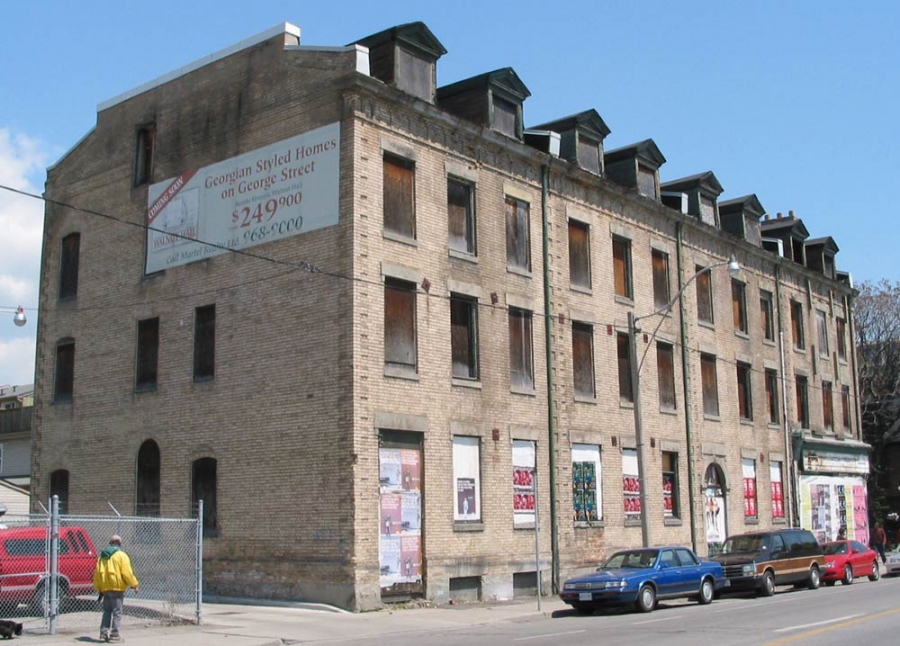Christopher Hume –
You don’t have to do much to get rid of a heritage building in Toronto. In fact, you don’t have to do anything. For many owners of historic properties, doing nothing is a good way to do away with impediments to redevelopment…and profit.
It’s called “demolition by neglect,” and the city lets you get away with it. All you have to do is seal the doors and windows on your way out, then sit back and let time and the elements do the rest.
A quick look around Toronto reveals dozens of abandoned structures, buildings whose owners have turned their back on the city, its neighbourhoods, history and, indeed, its future.
In March, heritage activists in the Kensington Market area raised a stink about the sad fate of 106 Huron Street, a two-storey house dating from 1873. Left empty and deteriorating for years, it is not just another civic eyesore; it is a slap in the face of anyone who professes even the most passing affection and respect for Toronto. At a time when the shortage of housing has reached crisis proportions, it also represents an act of Hobbesian indifference.
One of the most outrageous instances of demolition by neglect occurred in 2007 when the city tore down the last surviving row of Georgian townhouses in Toronto after a wall partially collapsed. These four residences, on the north side of Shuter Street just east of Jarvis, were all that remained of a building type that defined residential architecture in Toronto from the 1790s to the 1860s. A series of owners, including the Royal Canadian Mounted Police, had studiously ignored the site for decades, leaving it unheated, unmaintained and literally falling apart.
This appalling episode shamed even the Philistines on Toronto City Council into action. By a vote of 32 to 2, our civic representatives instructed staff to write standards for the protection of heritage buildings. The city threatened delinquent landlords that it would carry out needed work if they failed to do so, and add the cost to the owners’ property taxes.
“This will reduce the number of decayed buildings,” said Kyle Rae, councillor for Toronto-Centre Rosedale, who led the charge against demolition by neglect. “There is a public will and a public interest in maintaining heritage properties.”
Alas, the intervening years have not been much better for preservationists. In the unseemly rush to condo-fy downtown, the city has clearly lost its ability to plan intelligently, let alone protect heritage. The relentless focus on owners’ bottom lines has turned Toronto into a city of bottom-feeders who devote their energy fighting over the remains of the fray.
At the north side of King Street east of Sherbourne, a derelict block of 19th-century storefronts is slated to make way for yet another intrusive “luxury” condo and has been left to rot. Perhaps the developer, Emblem, which has plans for a 43-storey tower, hasn’t read its own marketing blurb. It babbles on about “Toronto’s prestigious King Street,” which it calls a “captivating community [in a] highly coveted downtown neighbourhood.”
This from a developer that has wantonly inflicted serious and wholly unnecessary damage and disruption to a historic precinct from which it hopes to make fat profits. In an age of pop-up shopping when businesses are run out of shipping containers, such waste demonstrates corporate culture at its most sclerotic. Why do anything, when you can do nothing? Why bother?
The fundamental requirement of urban life, individual or corporate, is to be a good neighbour. Every abandoned property is a reminder of the failure of landlords and developers to accept any responsibility for the city that gives value not to mention life, to their property and their projects. Already, developers are allowed to snarl the city and its neighbourhoods for years on end to accommodate interminable construction. But all we hear is endless whining from put-upon builders about development charges, approval processes and red tape.
Worse still, every abandoned property is also a reminder of what can happen in a city that lacks self-respect, one that has rock-bottom expectations of residents. Regardless, most of us willingly shovel the snow, put out the trash, clean up after our dogs and pay our taxes.
As onerous as these steps may seem, we get a lot in return. Not as much as we want, perhaps, but a whole lot more than the alternative.




